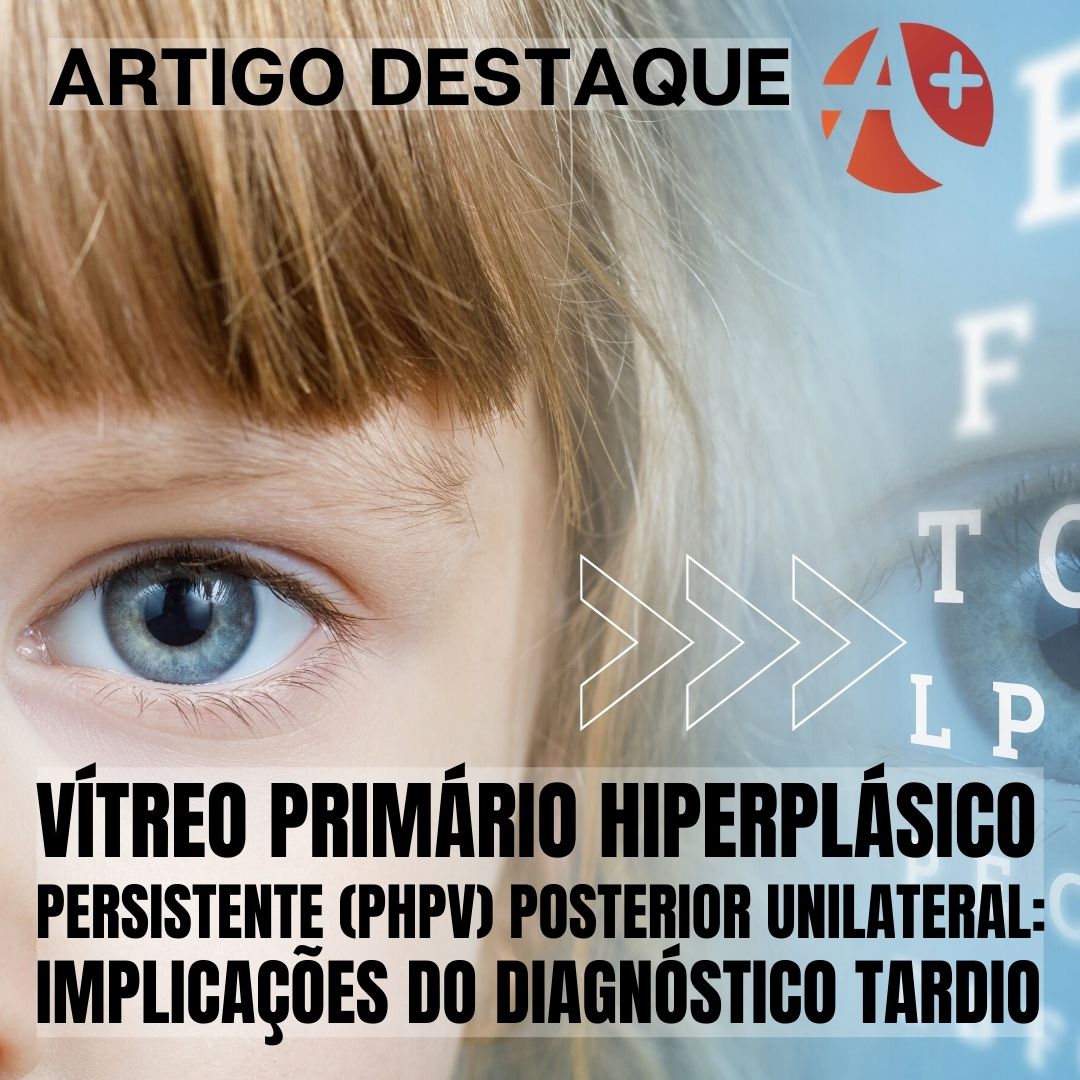Vítreo Primário Hiperplásico Persistente (PHPV) posterior unilateral: implicações do diagnóstico tardio
##plugins.themes.bootstrap3.article.main##
Resumo
Objetivo: Relatar um caso de Vítreo Primário Hiperplásico Persistente (PHPV) posterior e unilateral em uma criança, destacando a importância do diagnóstico precoce para um melhor prognóstico. Detalhamento do caso: Criança de dois anos, masculino, veio ao nosso serviço conduzido pela mãe, referindo que o filho estava com dificuldades para enxergar. Ao exame oftalmológico verificou-se: pupilas simétricas e isofotorreagentes, reflexo vermelho da retina sob midríase binocular, preservado em Olho Esquerdo (OE) e leucocoria no Olho Direito (OD). Retinografia do OE sem alterações aparentes, OD dobras retinianas com aspecto fibroso, opaco, grosseiro e de aparência irregular, cobrindo todo o fundo do olho e envolvendo a região macular. Vasos retinianos centrais não visíveis e na região periférica apresentam baixa nitidez. Ecografia oftálmica do olho direito apresentou ecos de membrana do vítreo primário posterior ao longo do eixo axial, visivelmente aderia ao disco óptico. Considerações finais: Neste estudo, diagnosticou-se tardiamente a PHPV posterior no globo ocular direito. A implicação da conduta foi expectante devido ao quadro evoluído, além das alterações em várias estruturas anatômicas do OD. Advertimos a importância da avaliação ocular nos recém-nascidos, evitando assim, o diagnóstico e tratamento tardios reduzindo lesões futuras com comprometimento estético e visual.
##plugins.themes.bootstrap3.article.details##
Copyright © | Todos os direitos reservados.
A revista detém os direitos autorais exclusivos de publicação deste artigo nos termos da lei 9610/98.
Reprodução parcial
É livre o uso de partes do texto, figuras e questionário do artigo, sendo obrigatória a citação dos autores e revista.
Reprodução total
É expressamente proibida, devendo ser autorizada pela revista.
Referências
2. AZCARATE PM, et al. B-scan echography in cases of confirmed persistent fetal vasculature. J Pediatr Ophthalmol Strabismus, 2016; 53: 252-253.
3. BOSJOLIE A, FERRONE P. Visual outcome in early vitrectomy for posterior persistent fetal vasculature associated with traction retinal detachment. Retina, 2015; 35: 570-576.
4. CERON O, et al. The vitreo-retinal manifestations of persistent hyperplasic primary vitreous (PHPV) and their management. Int Ophthalmol Clin., 2008; 48(2): 53–62.
5. CHEN C, et al. Persistent Fetal Vasculature. Asia-Pacific Journal of Ophthalmology, 2019; 8(1): 86-95.
6. GALHOTRA R, et al. Bilateral persistent hyperplastic primary vitreous: A rare entity. Oman J Ophthalmol., 2012; 5: 58-60.
7. GOLDBERG MF. Persistent fetal vasculature (PFV): anintegrated interpretation of signs and symptoms associated with persistent hyperplastic primary vitreous (PHPV). Am J Ophthalmol., 1997; 124: 587–626.
8. HU A, et al. Ultrasonographic feature of persistent hyperplastic primary vitreous. Eye Sci., 2014; 29(2): 100-3.
9. HUNT A, et al. Outcomes in persistent hyperplastic primary vitreous. Br J Ophthalmol., 2005; 89(7): 859–63.
10. LI J, et al. Regression of fetal vasculature and visual improvement in nonsurgical persistent hyperplastic primary vitreous: a case report. BMC Ophthalmol., 2019; 19(1): 161.
11. LI L, et al. Surgical treatment and visual outcomes of cataract with persistent hyperplastic primary vitreous. International journal of ophthalmology, 2017; 10(3): 391-399.
12. MAQSOOD H, et al. Bilateral Persistent Hyperplastic Primary Vitreous: A Case Report and Review of the Literature. Cureus, 2021; 13(2): e13105.
13. PRAKHUNHUNGSIT S, BERROCAL AM. Diagnostic and Management Strategies in Patients with Persistent Fetal Vasculature: Current Insights. Clin Ophthalmol., 2020; 14: 4325-4335.
14. POLLARD ZF. Persistent hyperplastic primary vitreous: diagnosis, treatment and results. Trans Am Ophthalmol Soc., 1997; 95: 487-549.
15. RAMSAMY G, et al. The essentials of fundoscopy. British Journal of Hospital Medicine, 2017; 78(2): C28-C32.
16. REESE AB. Persistent hyperplastic primary vitreous (PHPV). Am J Ophthalmol., 1955; 40: 317.
17. SHASTRY BS. Persistent hyperplastic primary vitreous: congenital malformation of the eye. Clin Exp Ophthalmol., 2009; 37(9): 884–90.
18. SINGH N, et al. Bilateral primary hyperplastic persistent vitreous: report of two cases. GMS Ophthalmol. Cases, 2020; 10: Doc 42.
19. TRABOULSI EI, et al. Associated systemic and ocular disorders in patients with congenital unilateral cataracts: the Infant Aphakia Treatment Study experience. Eye (Lond), 2016; 30: 1170-1174.
20. TERESHCHENKO AV, et al. Femtosecond laser-assisted anterior and posterior capsulotomies in children with persistent hyperplastic primary vitreous. J Cataract Refract Surg. 2020; 46(4): 497-502.
21. YUSUF IH, et al. Unilateral persistent hyperplastic primary vitreous: intensive management approach with excellent outcome beyond visual maturation. BMJ Case Rep., 2015; bcr2014206525.

